
Battletoads is a beat 'em up/platform video game developed by Rare and published by Tradewest. It is the first installment of the Battletoads series and was originally released on 1 June 1991 for the Nintendo Entertainment System. It was subsequently ported to the Mega Drive and Game Gear in 1993, to the Amiga and Amiga CD32 in 1994, and released with some changes for the Game Boy in 1993 in the form of Battletoads in Ragnarok's World. In the game, three space humanoid toad warriors form a group known as the Battletoads. Two of the Battletoads, Rash and Zitz, embark on a mission to defeat the evil Dark Queen on her planet and rescue their kidnapped friends: Pimple, the third member of the Battletoads, and Princess Angelica.

Sunset Riders is a side-scrolling run and gun video game developed and released by Konami as an arcade video game in 1991. It is set in the American Old West, where the player(s) take control of bounty hunters who are seeking the rewards offered for various criminals.
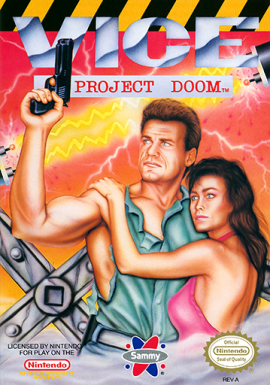
Vice: Project Doom, known in Japan as Gun-Dec (ガンデック), is an action video game developed by Aicom and published by Sammy Corporation for the Nintendo Entertainment System. The game was released in Japan on April 26, 1991, and in North America on November 1991. Vice: Project Doom is a side-scrolling platformer with noticeable similarities to the Ninja Gaiden series for the NES, with the addition of gun shooting and driving segments as well. The player assumes the role of a secret agent who must uncover a conspiracy involving a new kind of alien substance. A Sega Mega Drive conversion titled Deep Scanner was in development, but never released. It was released on Nintendo Switch Online in August 2019.

Contra Force is an run and gun game released by Konami for the Nintendo Entertainment System in 1992 in North America. It is a spinoff of the Contra series, being the third game in the series released for the NES following the original Contra and Super Contra. However, the game's plot and setting are unrelated to both previous and succeeding entries, as the villains in the game are human terrorists instead of an alien menace. The game was scheduled to be released in Japan under the title of Arc Hound, with no ties to the Contra series, but was cancelled.

Teenage Mutant Ninja Turtles III: The Manhattan Project is a side-scrolling beat-'em-up released by Konami for the Family Computer (Famicom) in Japan in 1991 and for the Nintendo Entertainment System in North America in 1992. It is the third video game iteration of the Teenage Mutant Ninja Turtles for the NES. The game features play mechanics similar to the previous game, Teenage Mutant Ninja Turtles II: The Arcade Game, but it is an original title for the NES without any preceding arcade version. It is based on the 1987 Teenage Mutant Ninja Turtles animated series, being released after the show's 5th season. The game was re-released as part of Teenage Mutant Ninja Turtles: The Cowabunga Collection in 2022.
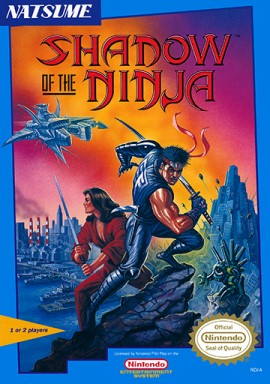
Shadow of the Ninja, originally released in Japan as Yami no Shigotonin Kage and later released in Europe and Australia as Blue Shadow, is a side-scrolling action game developed by Natsume for the Nintendo Entertainment System (NES) in 1990. The game revolves around a pair of ninja sent to assassinate a dictator in a futuristic version of New York City. A port was planned for the Game Boy, but was released in a rebranded form as Ninja Gaiden Shadow.
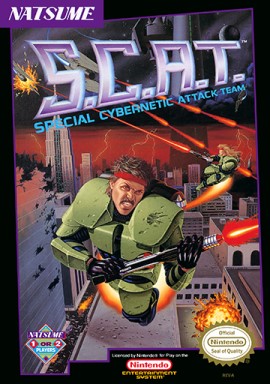
S.C.A.T.: Special Cybernetic Attack Team, also known as Final Mission in Japan and Action in New York in Europe, is a science fiction side-view shoot-'em-up produced by Natsume for the Nintendo Entertainment System. Within PAL-A regions, the game was only released in the UK. It was released in Japan in 1990, in North America in 1991, and in the PAL region in 1992. It was also later released on the Virtual Console in the PAL region on February 4, 2011, and in North America on February 7 for the Wii and in the PAL region on December 4, 2014 for the Nintendo 3DS and Wii U and was released on the Nintendo Switch via the Nintendo Switch Online service on September 23, 2020.

Legendary Wings is a fantasy-themed shoot-'em-up / platformer arcade video game released by Capcom in 1986. The player takes control of a young soldier equipped with magical wings who must save the world from a malfunctioning supercomputer. A home version for the Nintendo Entertainment System was released exclusively in North America in 1988. The original coin-op version is included in Capcom Classics Collection for PlayStation 2 and Xbox and in Capcom Classics Collection Remixed for PlayStation Portable.

Contra: Hard Corps, released as Contra: The Hard Corps in Japan and Probotector in Europe and Australia, is a run and gun video game released by Konami for the Sega Genesis in 1994, making it the first game in the Contra series released for a Sega platform.
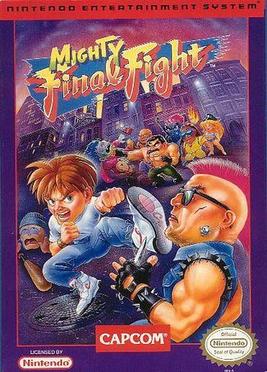
Mighty Final Fight is a side-scrolling beat-'em-up released by Capcom for the Nintendo Entertainment System in 1993. It is a spinoff of Capcom's 1989 arcade game Final Fight, which was previously ported to the Super NES. Unlike the CP System arcade classic and its SNES ports, the characters in this edition are depicted in a comical childlike "super deformed" or "chibi" art style in the same spirit as Famicom games such as both Konami's Kid Dracula and Namco's Splatterhouse: Wanpaku Graffiti.

Laser Invasion, released as Gun Sight (ガンサイト) in Japan, is a multi-genre first-person action game released by Konami for the Nintendo Entertainment System in 1991. The player takes control of a military operative who pilots an attack helicopter in order to infiltrate various enemy bases and fulfill his mission. The game supports the standard NES controller, as well as the NES Zapper light gun and the LaserScope, a voice-activated headset controller Konami released for the NES that was compatible with all light gun games released for the system. The American version of the game featured a rebate for the LaserScope in the instruction booklet.
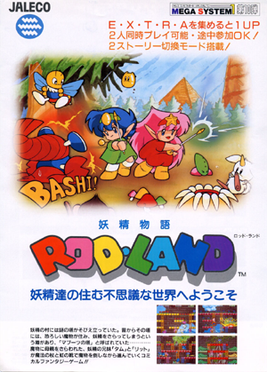
Rod Land, known in Japan as Yōsei Monogatari Rod Land, is a 1990 platform game originally developed and published in arcades by Jaleco.

The Lone Ranger is an 1991 action-adventure game released by Konami for the Nintendo Entertainment System (NES). Released only in North America, it is based on The Lone Ranger radio and TV franchise, the latter which was still rerunning in syndication when the game was released. The player takes the role of the Lone Ranger himself as he engages against outlaws in side-scrolling, overhead, and even first-person segments. The Lone Ranger theme music is played prominently during the game, which includes a DPCM-coded voice clip of the ranger shouting his catch-phrase "Hi Yo Silver".

Code Name: Viper, known in Japan as Ningen Heiki Dead Fox, is an action-platform video game developed by Arc System Works and published by Capcom in 1990 for the Nintendo Entertainment System. The player takes control of a special forces operative who must combat a drug syndicate in South America.
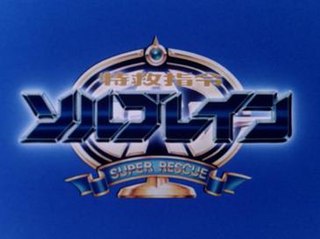
Super Rescue Solbrain is a Japanese tokusatsu television series produced by Toei Company. It ran for 53 episodes from January 20, 1991 to January 26, 1992 on TV Asahi. It is part of the Metal Hero Series franchise; a sequel to Special Rescue Police Winspector, it is the second installment in the Rescue Police Series trilogy.

Section Z is a horizontally scrolling shooter by Capcom, released as an arcade video game in 1985. A home version was published for the Nintendo Entertainment System in 1987.

Strider is an action-platform video game developed and published by Capcom for the Nintendo Entertainment System in North America in 1989. While the development of the NES version of Strider was produced in tandem with the arcade version, the Japanese version for the Famicom was never released. The NES version of Strider is included in the 2006 Game Boy Advance compilation Capcom Classics Mini-Mix.

Dragon Fighter (ドラゴンファイター) is a fantasy-themed side-scrolling action game developed by Natsume for the Nintendo Entertainment System. It was first published in Japan by Towa Chiki in 1990 and in North America by SOFEL in 1992.
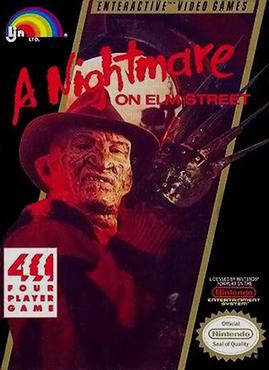
A Nightmare on Elm Street is a video game released on the Nintendo Entertainment System in 1990 based on Wes Craven's slasher film of the same name. The game was developed by Rare and published by LJN. It should not be confused with an unrelated game with the same title for the Commodore 64 and IBM PC released in 1989.

Captain Commando is a 1991 futuristic side-scrolling beat 'em up originally developed and published by Capcom as an arcade video game, and later ported to several other platforms. It was the seventeenth game produced for the company's CP System hardware. The game stars the titular superhero who was originally conceived as a fictional spokesman used by Capcom USA in the company's console games during the late 1980s. On September 13, 2018, Capcom announced Capcom Beat 'Em Up Bundle with Captain Commando being one of seven titles and released digitally for Nintendo Switch, PlayStation 4, Xbox One, and Windows on September 18, 2018.




















